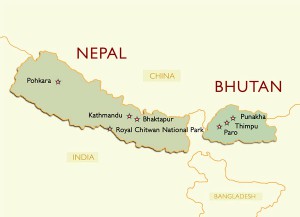"A Day in the Life" with Guru
/It is 9 a.m. and rain falls steadily outside the Avondale train station in Decatur, where a group of commuters lingers under the roof of the station, hesitant to get wet so early in the morning. Some people, however, do not have the luxury of waiting around until the rain abates. For a refugee services case manager, the morning is already in full swing: rain or shine, refugee clients need to be driven to health screenings, English lessons, work interviews, and orientations. Guru, one of LSG’s Refugee Services case managers, has already been quite busy this morning. When he pulls into the train station in his minivan to pick me up a few minutes after nine, he has already shuttled several clients to a clinic near Clarkston.

Guru has graciously agreed to take an inexperienced and inquisitive intern along with him while he visits families in Clarkston. As we drive on Ponce de Leon Avenue toward our destination, Guru tells me a little bit about his own story and how it relates to other refugees’ experiences. Originally from Bhutan, Guru came to the United States in 2008, after having spent 17 years as a refugee, mostly in a refugee camp in Nepal. It is not uncommon for refugees from Bhutan to have spent as many as twenty years in a Nepalese refugee camp. In the early 1990s, the Lhotshampas, the Nepali-speaking ethnic group from the south of Bhutan, were expelled from the country. To grasp the reason for this expulsion, one must understand the relationships between Bhutan’s various ethnic groups.
The ethnic groups in Bhutan have different customs and languages. The Ngalops, from the west of Bhutan, are the dominant ethnic group in Bhutan, controlling the government and dictating the cultural norms. The Sharchops, from the east, are the other powerful ethnic group. Together these two groups account for 65% of the population. The Lhotshampas constitute the other 35% of the population. Originally from Nepal, the Lhotshampas were invited by the Bhutanese government in the late 19th century to farm the land in the country’s southern, uninhabited foothills. The Lhotshampas were different from the powerful Ngalops—they spoke a different language, wore different clothes, and practiced a different religion—and these differences caused tension between the groups. In the 1980s, the Ngalop-controlled government began to view the Lhotshampas as a threat to the uniformity of its culture and implemented a series of political measures designed to impose the Ngalop’s culture on the Bhutanese people. In 1989, for example, the government mandated that people wear traditional, northern dress in public or risk incurring a fine—a policy that forces the Lhotshampas in the south to change their customs of dress. Once the Lhotshampas protested this policy and others like it, the government went a step further and began to expel Lhotshampas from the country in the early 1990s. Because the Lhotshampas shared a language and other aspects of culture with Nepalese citizens, they settled in camps there.
Seven Bhutanese refugee camps were set up in eastern Nepal, and the refugee population in those camps grew from 80,000 in 1992 to 105,000 in 2007. According to the UN Refugee Agency (UNHCR), as of January 31, 2012, only three of those seven original camps remain, in which 53,886 refugees live. The number of refugees and camps has declined because the inhabitants have been resettled permanently to other countries such as the United States, Australia, and Denmark. Finally moving from a refugee camp to a new country can be good news for someone who desires the security and comfort that were lacking in the camps. As Guru reminds me, though, many of these refugees have had to spend almost 20 years living in these camps, unable to find much work, reliant on the UNHCR for food, clothing, and shelter. For some, the relief at moving to a new country may be tempered by a sense of loss—of one’s home and of one’s time.
Websites consulted: http://www.unhcr.org; http://www.bhutaneserefugees.com
Check out the blog this following Thursday for the next section of A Day in the Life with Guru
Jeff Banks is the communications coordinator for LSG. If you have questions or comments, please contact him at jbanks@lsga.org.













